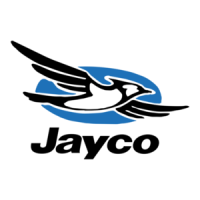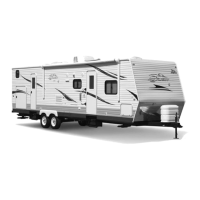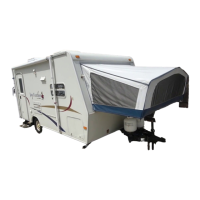appear at the leaky points. When tightening connections, use two
wrenches
with
opposing torque to prevent twisting of copper tubing.
If
the leak doesn't show
up
in
the
manifold or copper tubing
d-istribution system, then check the appliances.
E.P.-GAS
REGULATOR
SETTING
Never attempt to reset the gas regulator yourseif. Have an
authorized service agency make any regulator adjustments. Even
a
little amount of pressure over the recommended setting can cause
damage
to appliances and
regulators.
This
pressure setting
must
be
performed with a gas pressure gauge or monometer. Follow the
instructions given by the manufacturer of the regulator.
If
you
travel alternately
on
wet
roads
and
in
freezing weather,
be
sure
your E.P.-gas regulator
is
protected from
road
spray.
It'
water
enters
the vent in the regulator it may freeze the pressure controlling
diaphragm in
the
open position so that the container pressure
is
applied to the appliances--a hazardous condition.
Keep
your
regulator clean and
dry.
Follow the instructions given by
the
manufacturer
of
the regulator.
CAUTION:
Never
smoke
during
fillirmg
of
L.P.-tanks.
Keep
the
R.V.
away
Erom immediate
filIEng
area
when
possible
or
extinguish
all
gas
pilot
lights.
When a L.P.-tank gets low.
sometimes there is a concentration of
0
garlic-like odor which
may
be mistaken for a gas leak,
if
gas
is
being
burned. After changeover to a full tank,
the
odor usually will soon
disaeuear. Over-filled tanks will sometimes "blow off" excess
L
I
pressure when exposed to direct sunlight or hot temperatures.
If
this
becomes objectionable, remove
the
tank, take to a
safe
area, and
open the supply
line
valve to allow excess pressure to escape.
LP.-GAS
CONSUMPTION
Most gas appliances are only operated intermittently. Unless there
is
heavy use of hot water, water heater consumption is
not
too great.
During freezing weather and high wind conditions, furnace
consumption
can
be extremeIy heavy.
L.P.-gas consumption
depends
upon individual
use
of
appliances
and
the length
of
time operated. Each gallon of L.P.-gas produces about
91,500
BTU's
of heat energy. Following
is
a list of typical ap'pliance
consumption
when
turned full on for one hour
of
operation:

